Beginnen wir mit dem Land, in dem es zwar relativ kalt ist, einem dies aber mit Nordlichtern und Ahornsirup erträglich gemacht wird. Ein Künstler, um den man nicht herumkommt, wenn es um Origami in Kanada geht, ist Joseph Wu. Er ist der Mann, der auf Conventions gerne mal sagt: „Nennt mir etwas, das ich falten soll und ich falte es.“ So erstellte er auf dem Origami Deutschland Treffen in Schwäbisch Gmünd zum Beispiel sein eigenes Gesicht.
Gemäß seinem Motto sind auch die Modelle, die er erstellt äußerst kreativ, wie eine Wolverine Maske, eine wunderschöne Kokeshi (mein Liebling)oder für seinen Sohn Figuren aus dem Computerspiel „Plants vs. Zombies“.
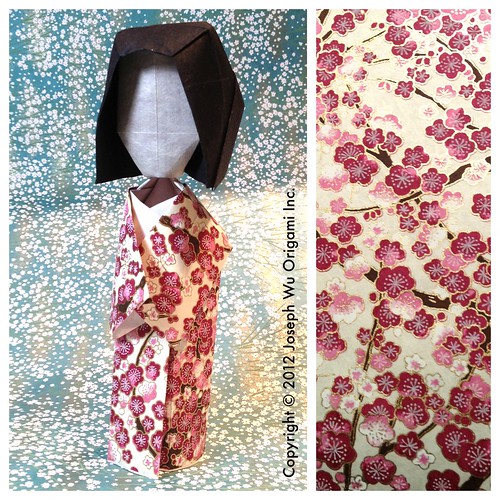 |
| Kokeshi von Joseph Wu (Modell, Faltung, Foto) - Kokeshi by Joseph Wu (model, folding, photo) |
Besonders passend zum Kanada Tag ist sein Trikot der Vancouver Canucks, seiner Lieblingseishockeymannschaft. Hierfür hat er sogar eine Videoanleitung erstellt und eine Druckvorlage veröffentlicht. Letztere lässt sich als pdf leider nicht mehr öffnen, doch auf der Seite „Vancouver is awesome“ gibt es eine JPG, die man dann einfach in ein Textdokument zum Ausdrucken einfügt.
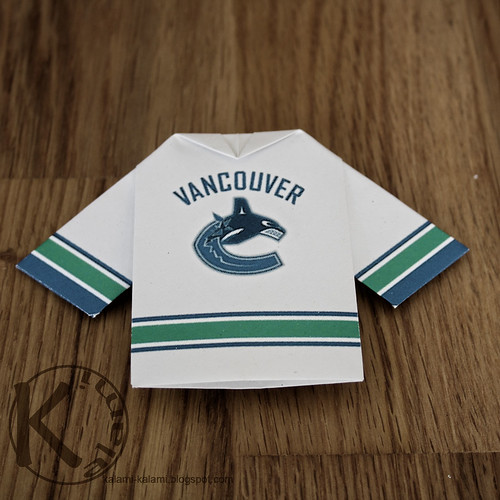 |
| Vancouver Canucks Trikot von Joseph Wu |
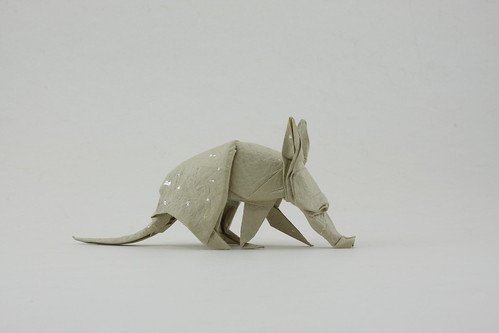 |
| Erdferkel von Quentin Trollip (Modell, Faltung, Foto) - Aardvark by Quentin Trollip (model, folding, photo) |
Am Pudu könnt Ihr Euch auch einmal selbst versuchen, denn Quentin hat dieses Modell freundlicherweise in der kostenfreien Zeitschrift „4 Esquinas“ in der 6. Ausgabe veröffentlicht.
 |
| Pudu designed by Quentin Trollip |
Und das ist dann auch die total zufällige Überleitung zum zweiten nordamerikanischen Land, das dieser Tage seine Gründung feiert, die USA.
Für die USA eine Auswahl an Origami Künstler zu treffen ist enorm schwer, denn es gibt sie hier in einer sehr hohen Anzahl. Hier ist eine kleine Auswahl (ohne Wertigkeit): Robert Lang, Eric Gjerde, Michael LaFosse, Bernie Peyton, Beth Johnson, Brian Chan, John Montroll und viele mehr.
Daher habe ich beschlossen, für diesen Teil eher auf vier Modelle einzugehen, die in irgendeiner Weise symbolisch für die USA stehen (können).
Den Anfang macht eine amerikanische Persönlichkeit, die weit über die Grenzen hinaus bekannt ist, Abraham Lincoln, der der 16. amerikanische Präsident und Anführer der Nordstaaten im Sezessionskrieg war. Sein Konterfei ziert den fünf Dollar Schein und wurde von Carlos González Santamaría (aka Halle) als Origami Maske gekonnte gestaltet. Die Anleitung ist in seinem Buch „Origami VIP“ zu finden.
Sehr stereotypisch geht es weiter mit einem Cowboy Hut, der einst von David Petty diagrammiert wurde.
Von einem Cowboyhut ist es dann auch nicht mehr weit bis zu diesem kleinen Kerlchen, der von Anita Barbour „Mus musculus, var. Famoso“ genannt wurde. Scrollt mal runter in den englischen Teil, vielleicht erkennt Ihr ihn ja.
Etwas anspruchsvoller und deshalb auch ohne Diagramm ist da die Flagge der USA, eindrucksvoll aus einem einzigen Blatt Papier gefaltet von Robert Lang. Ihr seid der Meinung, das kriegt Ihr hin? Na OK, Robert Lang war so gut und teilt mit der Internetgemeinde das Crease Pattern. Klickt einfach oben auf den Link zu Flagge und scrollt ein bisschen runter, da findet Ihr den Verweis auf des Crease Pattern.
 |
| US Flagge von Robert Lang (Modell, Faltung, Foto) - US flag by Robert Lang (model, folding, photo) |
Zu guter Letzt sollte aber auch daran erinnert werden, dass diese Staatswerdungen nicht ohne ihre Schattenseiten vollzogen wurden. Sowohl auf dem Gebiet Kanadas, als auch in den heutigen USA gab es auch schon vor der Besiedlung durch die Europäer Menschen. Die Cherokee, Sioux, Choctaw und Irokesen wurden im Zuge der Eroberung des Kontinents gnadenlos verdrängt und ermordet. Daher soll das letzte Modell an eben diese indigene Bevölkerung erinnern:
 |
| Modell, Faltung und FOto von Joseph Wu - ich habe versucht einen eigenen Totempfahl zu falten, aber das Ergebnis war nicht vorzeigbar. |
These days two North-American Nations are celebrating their independenceCorrect, on July the first Canadians celebrated the Canada Day and on July the fourth the USA celebrates the Independence Day. Reasons enough for me to have a look at the Origami side of those countries.
Let’s start with the state that can be quite cold, but helps us to stand this with the aurora borealis and maple syrup.
One artist, you have to know when you are talking about Origami in Canada is Joseph Wu. He is the man, who likes to say, “Tell me something you want me to fold and I will do it”, during conventions. As an example he folded his own face at the German meeting in Schwäbisch Gmünd.
According to this motto his models are very creative, like a Wolverine mask, a beautiful Kokeshi (my favourite) or the characters of “Plants vs. Zombies” he made for his son.
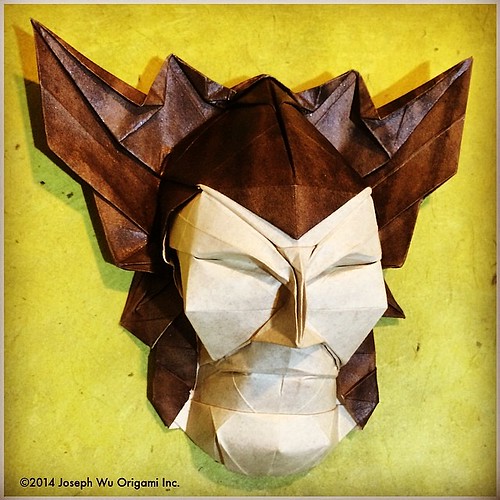 |
| Wolverine Maske von Joseph Wu (Modell, Faltung, Foto) - Wolverine mask by Joseph Wu (model, folding, photo) |
Perfect for the theme Canada Day is his shirt of the Vancouver Canucks, his favourite hockey team. He even made a video instruction for it and a printable template so you can make your own Canucks shirt. Unfortunately the pdf of the template can’t be downloaded anymore, but you can get a jpeg at the site “Vancouver is awesome”, which you can put into a text file and print.
 |
| Vancouver Canucks Shirt by Joseph Wu |
The second Canadian Origami artist that comes to my mind is Quentin Trollip (he was born and raised in Southafrica and later moved to Canada). Mostly he designs animals which are not only high quality models but also represent a huge variety of different species. For example there is a Macaw, a Pudu (the smallest deer on earth) and my most favourite, because the model is shaped so expressively, an Aardvark.
As the artist was so kind to publish the diagram of the Pudu in the free magazine “4 Esquinas No.6”, you can try to fold your own little deer.
 |
| Pudu designed by Quentin Trollip |
And this leads us by total coincidence to the second celebrating North-American state, the USA.
For the USA it is very difficult to find one or two special Origami artists, because you find so many of them living there. Here are only some of them (without any ranking): Robert Lang, Eric Gjerde, Michael LaFosse, Bernie Peyton, Beth Johnson, Brian Chan, John Montroll and many more.
Therefor I’ve decided to show four models in this part that might be seen as a symbol of the USA. Let’s start with a person that is well known all over the world, Abraham Lincoln, the 16th president and the leader of the Union States during the Civil War. His portrait is on the five Dollar bill and was folded by Carlos González Santamaría (aka Halle) as an Origami mask in a quite impressive way. The diagram can be found in his book “Origami VIP”.
A very stereotypical symbol is this cowboy hat diagrammed by David Petty. See the photo above in the German part.
And when you’ve already folded the cowboy hat it is only a small step to come to this little fellow called “Mus musculus, var. Famoso“ by Anita Barbour. Do you recognize him?
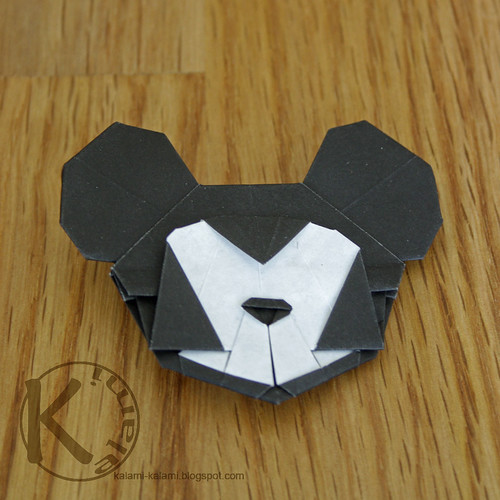 |
| Mouse designed by Anita Barbour |
In the end I also want to state out that the development of those two states had its darker side. As well in the area of Canada as in the United States there were other people living when the Europeans arrived at the new continent. For example the Cherokee, Sioux, Choctaw and Iroquois were suppressed and murdered during the conquest of the land. Therefor the last model shall remember the Native Americans.
 | ||
| Model, folding and photo by Joseph Wu - I tried to make my own totem pole but result was really lame. |



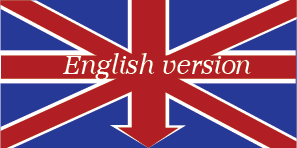
sehr sehr schöner Artikel!
AntwortenLöschenjetzt verstehe ich auch deine Frage von neulich... ;-)
der direkte link zu Robert Langs CP funktionert übrigens so nicht. man muss irgendwie zu der CPs-Unterwebseite oder so verlinken.
Danke Robin! Hab den Link zum CP überarbeitet.
AntwortenLöschenDein Artikel ist wieder wunderbar geschrieben Tine. Morgen poste ich auf Flickr deinen Carmens Stern :) Liebe Grüße Uwe
AntwortenLöschenEigentlich dachte ich, ich hätte schon auf Deinen Kommentar geantwortet, aber das ist scheinbar im Nirvana des Internets verschwunden.
LöschenIch danke Dir für den lieben Kommentar Uwe und bin schon sehr gespannt auf den Stern!